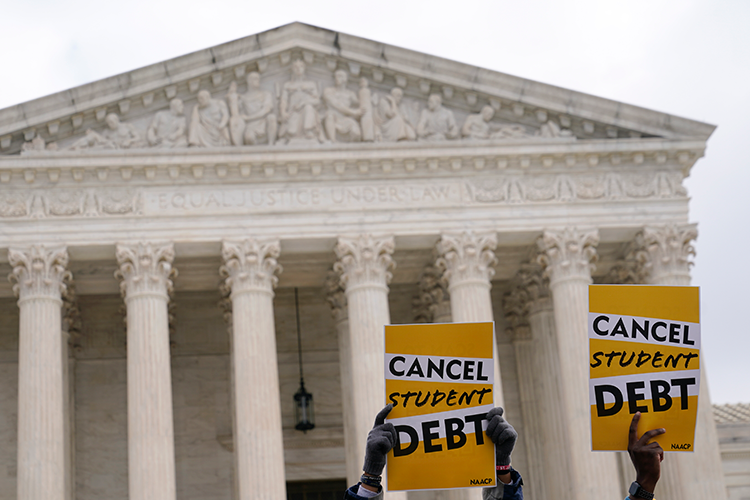Chemerinsky: Student loan relief cases will have lasting effects whatever Supreme Court decides

Student-debt relief advocates gather outside the Supreme Court on Tuesday as the justices hear arguments over President Joe Biden’s student-debt relief plan. Photo by Patrick Semansky/The Associated Press. Adjacent image from Shutterstock.
No matter what the U.S. Supreme Court does in the cases involving the Biden administration’s student loan relief plan, there is sure to be a major effect on many people’s lives and on the law. On Tuesday, Feb. 28, the court heard oral arguments in two cases—Biden v. Nebraska and Department of Education v. Brown—that raise myriad legal issues and any path taken by the court will have significant consequences. (I was among 24 legal scholars who signed an amicus brief in support of the Biden administration).
The cases involve a Biden administration program where up to 40 million borrowers could receive up to $20,000 in cancellation of government-owned federal student loans. More than 26 million borrowers had applied for debt relief, and more than 16 million were approved, before federal courts halted the initiative in the cases now before the Supreme Court. It was actually the Trump administration, in the midst of the pandemic, that began this debt relief. Now, though, it is conservative states and activists who are challenging the Biden administration’s actions.
The Biden administration claimed the authority to do this is under a federal law that was adopted in 2003, after 9/11. The Health and Economic Recovery Omnibus Emergency Solutions Act, also known as the HEROES Act, gives the Secretary of Education the statutory authority to “waive or modify any statutory or regulatory provision applicable to the student financial assistance programs” in response to a “national emergency.” The Biden administration claims the pandemic constitutes the national emergency.
If the court dismisses the cases or approves the debt relief, it will make an enormous difference to millions of people in providing relief from a significant financial burden. But if the court rules against the Biden administration, there could be implications for many other federal laws as well.
 Related article from ABAJournal.com: “Student debt relief meets with skepticism from majority of Supreme Court justices”
Related article from ABAJournal.com: “Student debt relief meets with skepticism from majority of Supreme Court justices”
A matter of standing
The threshold issue in both cases is whether the plaintiffs have standing to bring the challenges. Many courts had dismissed suits against the Biden administration’s student debt relief actions on the ground that the plaintiffs failed to demonstrate an injury sufficient for standing.
In Biden v. Missouri, the question is whether state governments are sufficiently hurt to be able to sue. Six states with Republican administrations filed suit. The St. Louis-based 8th U.S. Court of Appeals found the states had standing because the Biden administration’s student loan forgiveness plan would decrease state revenue by encouraging borrowers with commercial loans backed by state-related guaranty agencies to move their loans over to the federal government’s direct lending program through consolidation.
But the United States, in its brief to the court, argues any link between Biden’s student loan forgiveness program, state-affiliated guaranty agencies and state revenue is speculative. As my colleague, Jonathan Glater, recently wrote in SCOTUSblog, this is “akin to arguing that if A owes money to B and B owes money to C, then C can sue A to compel payment of B, because otherwise B might not pay C. That is speculative.” Also, the state guaranty agencies are not the ones challenging the Biden program.
The underlying question, which is raised in a number of cases on the Supreme Court’s docket this term, is: Under what circumstances do states have standing to sue to challenge federal government policies? There has been an explosion of such suits, by Democratic-led states in the Trump years and now by states headed by Republicans.
Department of Education v. Brown is a lawsuit by two individuals with student loan debt, Myra Brown and Alexander Taylor, challenging their exclusion from Biden administration’s programs. They argue that the Biden administration violated the Administrative Procedures Act by not engaging in notice and comment rule-making before excluding commercial loans from relief and by imposing limits on the amount of forgiveness it would extend to borrower.
Again, though, there is the question of whether they have standing. Any government benefit program draws lines as to who can receive the assistance. Do those excluded have an injury sufficient for standing? Moreover, if the Biden administration plan is enjoined, then these individuals still will end up with nothing. How then would a favorable court decision remedy their injury, which is a requirement for standing?
 Erwin Chemerinsky. Photo by Jim Block.
Erwin Chemerinsky. Photo by Jim Block.The HEROES Act and the ‘major questions’ doctrine
If the Supreme Court finds standing in either case, then it must confront whether the Biden administration had authority under the statute to provide this student loan relief. The HEROES Act of 2003 authorizes the Secretary of Education to “waive or modify any statutory or regulatory provision” pertaining to federal student loan programs as the Secretary “deems necessary in connection with a … national emergency.”
The United States, in its brief, argues that “[t]he plain language of the HEROES Act authorizes the plan. … Here, the Secretary responded to the devastating economic consequences of the COVID-19 pandemic by granting targeted relief to borrowers at higher risk of delinquency and default due to the pandemic—specifically, by waiving and modifying certain provisions governing student loan cancellation and discharge. That relief falls squarely within the Secretary’s express statutory authority.”
The six states challenging the Biden administration’s plan argue that “this is a major-questions case.” The Supreme Court has ruled, as recently as last June 30 in West Virginia v. Environmental Protection Agency, that a federal agency can act, when there is a major question of economic or political significance, only if there is clear direction from Congress. The challengers argue that this would excuse “$430 billion owed to the Government and cost taxpayers more than a half-trillion dollars over 10 years.” They say “the political significance is likewise undeniable. student loan cancellation is a matter of ‘earnest and profound debate.’” The challengers argue that there was not sufficiently clear authority from Congress for such “an unheralded” act.
By contrast, the United States argues that the “major questions” doctrine is inapplicable because the statutory authority is clear as to the Secretary of Education’s power to provide relief and has been used previously by both Democratic and Republican administrations. The United States objects that the challengers are attempting to “wield the doctrine as a trump card to override plain text for all agency actions that can be characterized as significant.”
There is enormous ambiguity about the major questions doctrine. The Supreme Court has given relatively little guidance as to when it applies, what constitutes a major question of economic or political significance, and what is sufficiently specific guidance from Congress to meet it. There are dozens, likely hundreds, of lawsuits in the lower courts where federal agency actions are challenged on major questions doctrine grounds. This case could provide further clarification of this relatively new doctrine.
The issue in Secretary of Education v. Brown is whether the Department of Education failed to follow the notice and comment rule-making under the Administrative Procedures Act. Interestingly, the United States, in its consolidated brief in both cases, spends only a few pages on this. It argues that the HEROES Act “expressly exempts the Secretary from complying with ‘section 553 of title 5’”—i.e., the APA’s notice and comment requirement—when issuing waivers and modifications under the Act.
Lurking in the background of these cases is the Biden administration’s announcement that it is ending the declarations of a COVID-19 emergency on May 11. The issue before the court is whether the Biden administration’s action was valid when it was taken. And the COVID-19 emergency declarations remain in place now and still could be extended. Yet, one wonders whether this practical reality might affect how the court deals with the difficult issues presented in these cases.
See also:
ABAJournal.com: “Changes are proposed to Public Service Loan Forgiveness program as part of student loan debt relief”
ABAJournal.com: “Supreme Court will consider challenge to Biden’s student-debt relief program, puts case on fast track”
ABAJournal.com: “Biden administration extends pause on federal student loan payments as SCOTUS review is sought”
Erwin Chemerinsky is dean of the University of California at Berkeley School of Law and author of the newly published book A Momentous Year in the Supreme Court. He is an expert in constitutional law, federal practice, civil rights and civil liberties and appellate litigation. He’s also the author of The Case Against the Supreme Court; The Religion Clauses: The Case for Separating Church and State, written with Howard Gillman; and Presumed Guilty: How the Supreme Court Empowered the Police and Subverted Civil Rights.
This column reflects the opinions of the author and not necessarily the views of the ABA Journal—or the American Bar Association.
Clarification
Updated on March 10 to disclose that Erwin Chemerinsky signed an amicus brief in support of the Biden administration’s position.
Write a letter to the editor, share a story tip or update, or report an error.


